University Leadership Module: Kotter's and Lewin's Model Comparison
VerifiedAdded on 2022/08/13
|6
|1299
|50
Report
AI Summary
This report provides a comparative analysis of two prominent change management models: Kotter's eight-step process and Lewin's three-step model. The report begins with an introduction to the concept of change management and its significance in organizations, highlighting the need for effective strategies to navigate transitions. It then delves into Lewin's model, detailing the unfreezing, changing, and refreezing stages, and emphasizes the importance of communication and participation. Following this, the report outlines Kotter's model, describing each of the eight steps, including establishing a sense of urgency, creating a guiding coalition, developing a vision, and anchoring changes. The comparison focuses on key aspects such as the awareness of the need for change, communication strategies, the desire to change, resistance management, reinforcement techniques, training and knowledge, and measurement methods. The report concludes by synthesizing the strengths of both models and suggesting how they can be integrated for more effective change management, emphasizing the importance of understanding the context and the readiness of people to accept change.
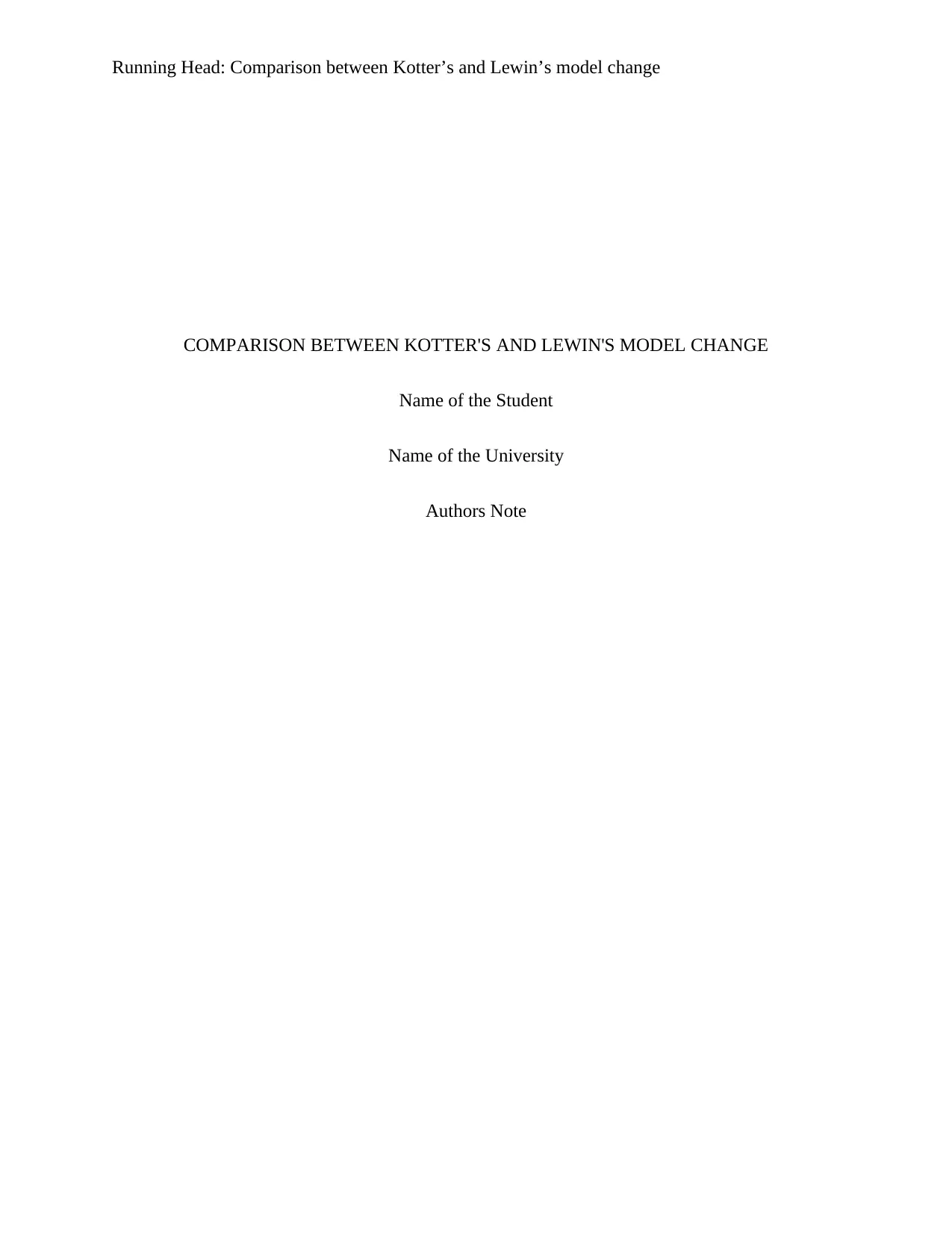
Running Head: Comparison between Kotter’s and Lewin’s model change
COMPARISON BETWEEN KOTTER'S AND LEWIN'S MODEL CHANGE
Name of the Student
Name of the University
Authors Note
COMPARISON BETWEEN KOTTER'S AND LEWIN'S MODEL CHANGE
Name of the Student
Name of the University
Authors Note
Paraphrase This Document
Need a fresh take? Get an instant paraphrase of this document with our AI Paraphraser
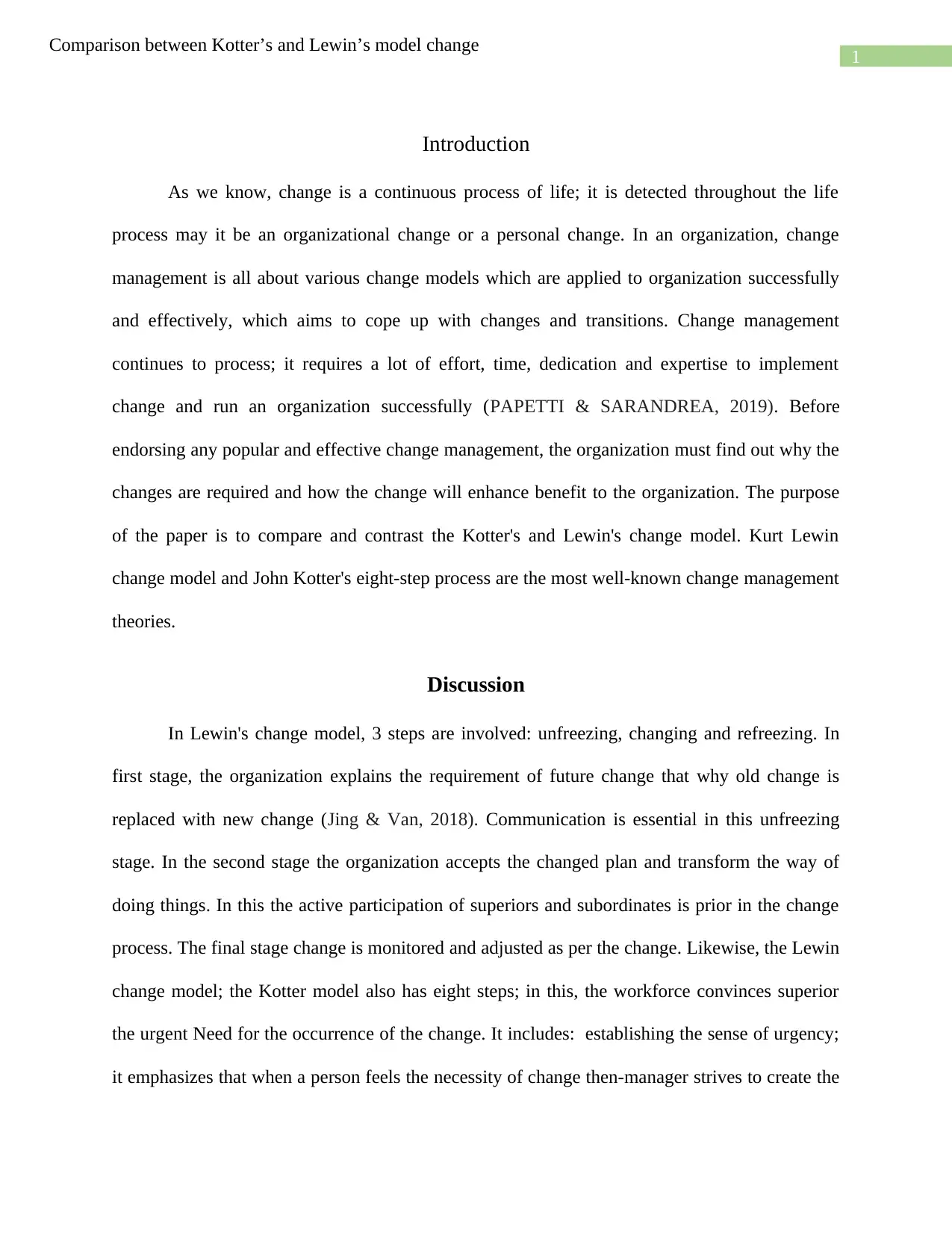
1
Comparison between Kotter’s and Lewin’s model change
Introduction
As we know, change is a continuous process of life; it is detected throughout the life
process may it be an organizational change or a personal change. In an organization, change
management is all about various change models which are applied to organization successfully
and effectively, which aims to cope up with changes and transitions. Change management
continues to process; it requires a lot of effort, time, dedication and expertise to implement
change and run an organization successfully (PAPETTI & SARANDREA, 2019). Before
endorsing any popular and effective change management, the organization must find out why the
changes are required and how the change will enhance benefit to the organization. The purpose
of the paper is to compare and contrast the Kotter's and Lewin's change model. Kurt Lewin
change model and John Kotter's eight-step process are the most well-known change management
theories.
Discussion
In Lewin's change model, 3 steps are involved: unfreezing, changing and refreezing. In
first stage, the organization explains the requirement of future change that why old change is
replaced with new change (Jing & Van, 2018). Communication is essential in this unfreezing
stage. In the second stage the organization accepts the changed plan and transform the way of
doing things. In this the active participation of superiors and subordinates is prior in the change
process. The final stage change is monitored and adjusted as per the change. Likewise, the Lewin
change model; the Kotter model also has eight steps; in this, the workforce convinces superior
the urgent Need for the occurrence of the change. It includes: establishing the sense of urgency;
it emphasizes that when a person feels the necessity of change then-manager strives to create the
Comparison between Kotter’s and Lewin’s model change
Introduction
As we know, change is a continuous process of life; it is detected throughout the life
process may it be an organizational change or a personal change. In an organization, change
management is all about various change models which are applied to organization successfully
and effectively, which aims to cope up with changes and transitions. Change management
continues to process; it requires a lot of effort, time, dedication and expertise to implement
change and run an organization successfully (PAPETTI & SARANDREA, 2019). Before
endorsing any popular and effective change management, the organization must find out why the
changes are required and how the change will enhance benefit to the organization. The purpose
of the paper is to compare and contrast the Kotter's and Lewin's change model. Kurt Lewin
change model and John Kotter's eight-step process are the most well-known change management
theories.
Discussion
In Lewin's change model, 3 steps are involved: unfreezing, changing and refreezing. In
first stage, the organization explains the requirement of future change that why old change is
replaced with new change (Jing & Van, 2018). Communication is essential in this unfreezing
stage. In the second stage the organization accepts the changed plan and transform the way of
doing things. In this the active participation of superiors and subordinates is prior in the change
process. The final stage change is monitored and adjusted as per the change. Likewise, the Lewin
change model; the Kotter model also has eight steps; in this, the workforce convinces superior
the urgent Need for the occurrence of the change. It includes: establishing the sense of urgency;
it emphasizes that when a person feels the necessity of change then-manager strives to create the
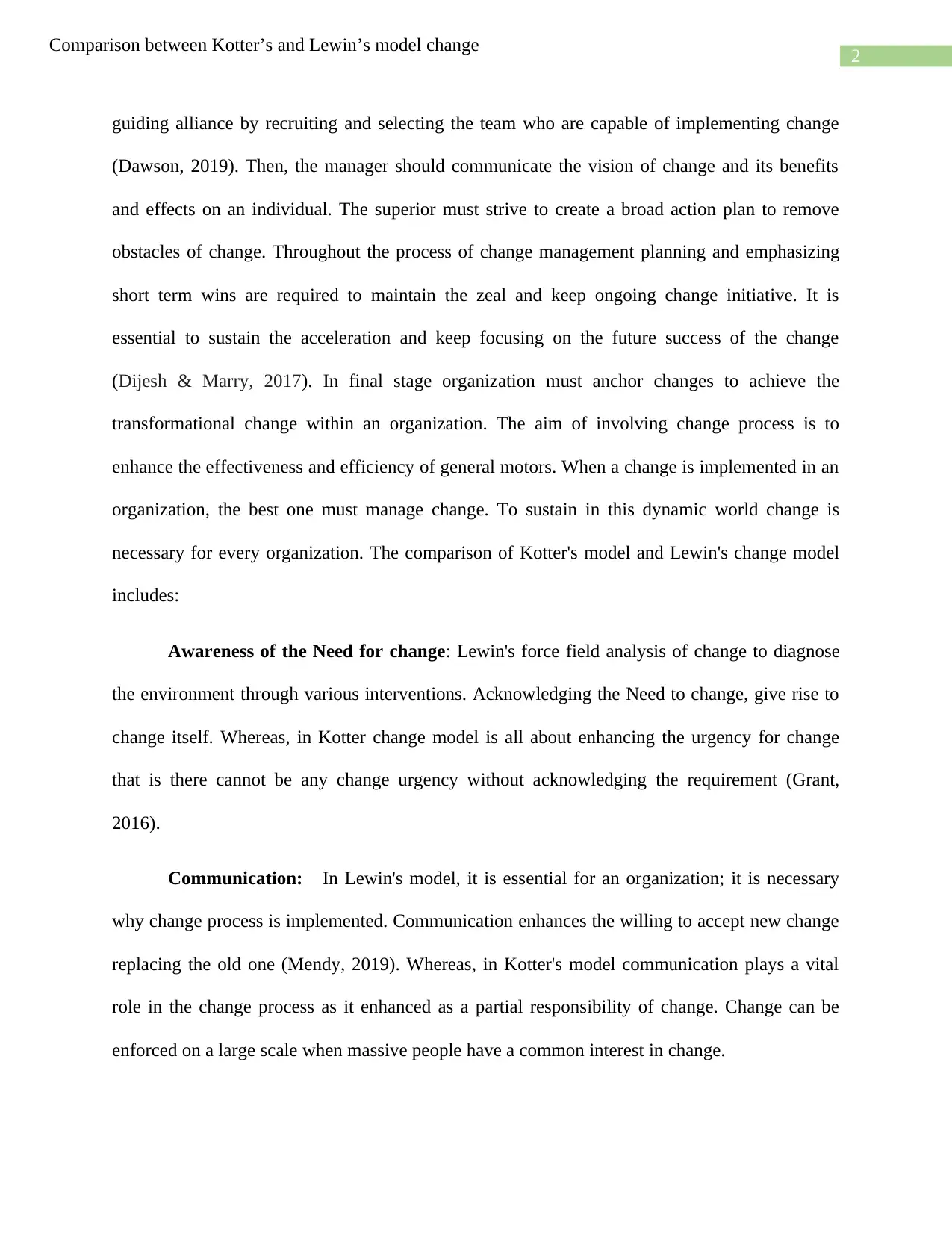
2
Comparison between Kotter’s and Lewin’s model change
guiding alliance by recruiting and selecting the team who are capable of implementing change
(Dawson, 2019). Then, the manager should communicate the vision of change and its benefits
and effects on an individual. The superior must strive to create a broad action plan to remove
obstacles of change. Throughout the process of change management planning and emphasizing
short term wins are required to maintain the zeal and keep ongoing change initiative. It is
essential to sustain the acceleration and keep focusing on the future success of the change
(Dijesh & Marry, 2017). In final stage organization must anchor changes to achieve the
transformational change within an organization. The aim of involving change process is to
enhance the effectiveness and efficiency of general motors. When a change is implemented in an
organization, the best one must manage change. To sustain in this dynamic world change is
necessary for every organization. The comparison of Kotter's model and Lewin's change model
includes:
Awareness of the Need for change: Lewin's force field analysis of change to diagnose
the environment through various interventions. Acknowledging the Need to change, give rise to
change itself. Whereas, in Kotter change model is all about enhancing the urgency for change
that is there cannot be any change urgency without acknowledging the requirement (Grant,
2016).
Communication: In Lewin's model, it is essential for an organization; it is necessary
why change process is implemented. Communication enhances the willing to accept new change
replacing the old one (Mendy, 2019). Whereas, in Kotter's model communication plays a vital
role in the change process as it enhanced as a partial responsibility of change. Change can be
enforced on a large scale when massive people have a common interest in change.
Comparison between Kotter’s and Lewin’s model change
guiding alliance by recruiting and selecting the team who are capable of implementing change
(Dawson, 2019). Then, the manager should communicate the vision of change and its benefits
and effects on an individual. The superior must strive to create a broad action plan to remove
obstacles of change. Throughout the process of change management planning and emphasizing
short term wins are required to maintain the zeal and keep ongoing change initiative. It is
essential to sustain the acceleration and keep focusing on the future success of the change
(Dijesh & Marry, 2017). In final stage organization must anchor changes to achieve the
transformational change within an organization. The aim of involving change process is to
enhance the effectiveness and efficiency of general motors. When a change is implemented in an
organization, the best one must manage change. To sustain in this dynamic world change is
necessary for every organization. The comparison of Kotter's model and Lewin's change model
includes:
Awareness of the Need for change: Lewin's force field analysis of change to diagnose
the environment through various interventions. Acknowledging the Need to change, give rise to
change itself. Whereas, in Kotter change model is all about enhancing the urgency for change
that is there cannot be any change urgency without acknowledging the requirement (Grant,
2016).
Communication: In Lewin's model, it is essential for an organization; it is necessary
why change process is implemented. Communication enhances the willing to accept new change
replacing the old one (Mendy, 2019). Whereas, in Kotter's model communication plays a vital
role in the change process as it enhanced as a partial responsibility of change. Change can be
enforced on a large scale when massive people have a common interest in change.
⊘ This is a preview!⊘
Do you want full access?
Subscribe today to unlock all pages.

Trusted by 1+ million students worldwide
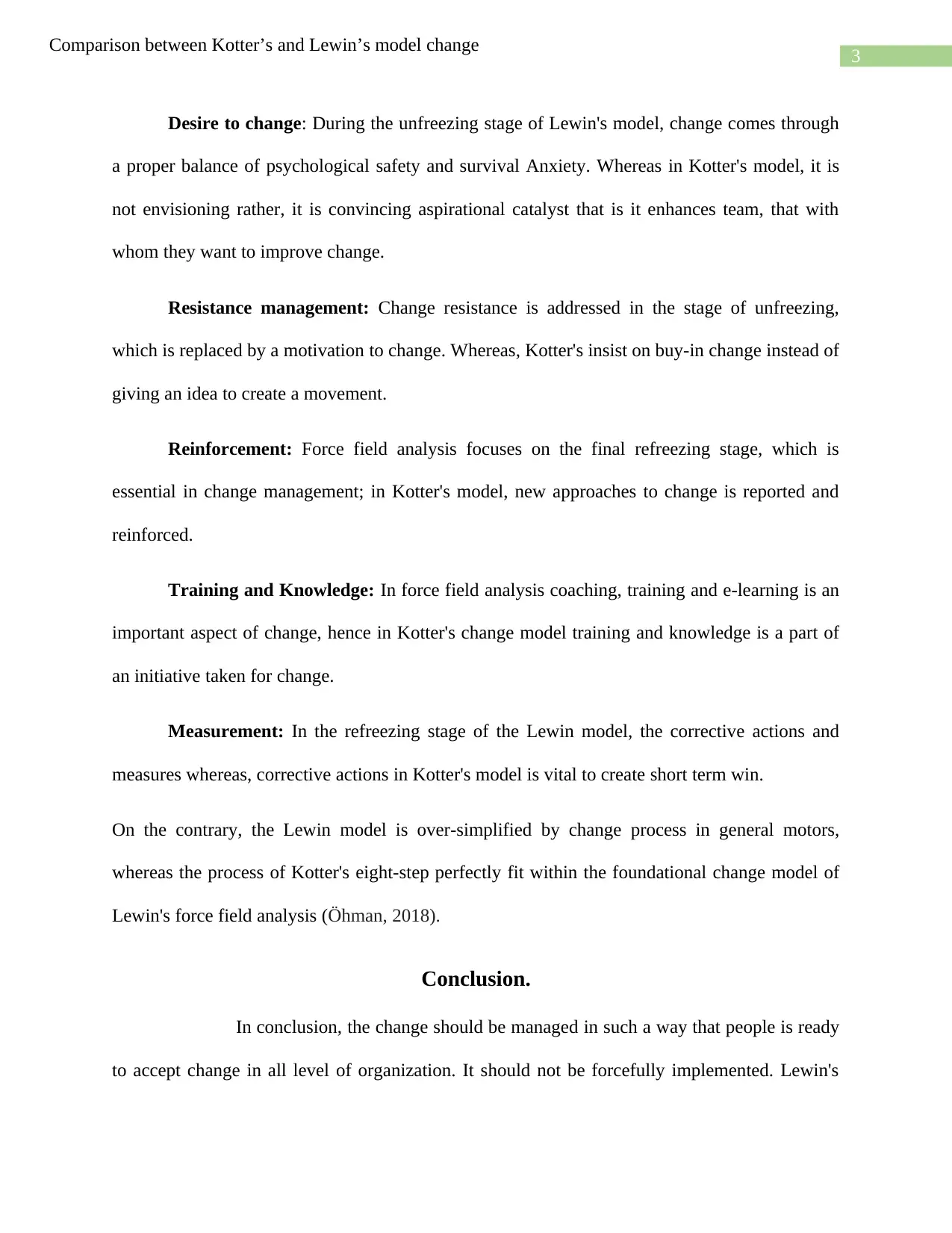
3
Comparison between Kotter’s and Lewin’s model change
Desire to change: During the unfreezing stage of Lewin's model, change comes through
a proper balance of psychological safety and survival Anxiety. Whereas in Kotter's model, it is
not envisioning rather, it is convincing aspirational catalyst that is it enhances team, that with
whom they want to improve change.
Resistance management: Change resistance is addressed in the stage of unfreezing,
which is replaced by a motivation to change. Whereas, Kotter's insist on buy-in change instead of
giving an idea to create a movement.
Reinforcement: Force field analysis focuses on the final refreezing stage, which is
essential in change management; in Kotter's model, new approaches to change is reported and
reinforced.
Training and Knowledge: In force field analysis coaching, training and e-learning is an
important aspect of change, hence in Kotter's change model training and knowledge is a part of
an initiative taken for change.
Measurement: In the refreezing stage of the Lewin model, the corrective actions and
measures whereas, corrective actions in Kotter's model is vital to create short term win.
On the contrary, the Lewin model is over-simplified by change process in general motors,
whereas the process of Kotter's eight-step perfectly fit within the foundational change model of
Lewin's force field analysis (Öhman, 2018).
Conclusion.
In conclusion, the change should be managed in such a way that people is ready
to accept change in all level of organization. It should not be forcefully implemented. Lewin's
Comparison between Kotter’s and Lewin’s model change
Desire to change: During the unfreezing stage of Lewin's model, change comes through
a proper balance of psychological safety and survival Anxiety. Whereas in Kotter's model, it is
not envisioning rather, it is convincing aspirational catalyst that is it enhances team, that with
whom they want to improve change.
Resistance management: Change resistance is addressed in the stage of unfreezing,
which is replaced by a motivation to change. Whereas, Kotter's insist on buy-in change instead of
giving an idea to create a movement.
Reinforcement: Force field analysis focuses on the final refreezing stage, which is
essential in change management; in Kotter's model, new approaches to change is reported and
reinforced.
Training and Knowledge: In force field analysis coaching, training and e-learning is an
important aspect of change, hence in Kotter's change model training and knowledge is a part of
an initiative taken for change.
Measurement: In the refreezing stage of the Lewin model, the corrective actions and
measures whereas, corrective actions in Kotter's model is vital to create short term win.
On the contrary, the Lewin model is over-simplified by change process in general motors,
whereas the process of Kotter's eight-step perfectly fit within the foundational change model of
Lewin's force field analysis (Öhman, 2018).
Conclusion.
In conclusion, the change should be managed in such a way that people is ready
to accept change in all level of organization. It should not be forcefully implemented. Lewin's
Paraphrase This Document
Need a fresh take? Get an instant paraphrase of this document with our AI Paraphraser
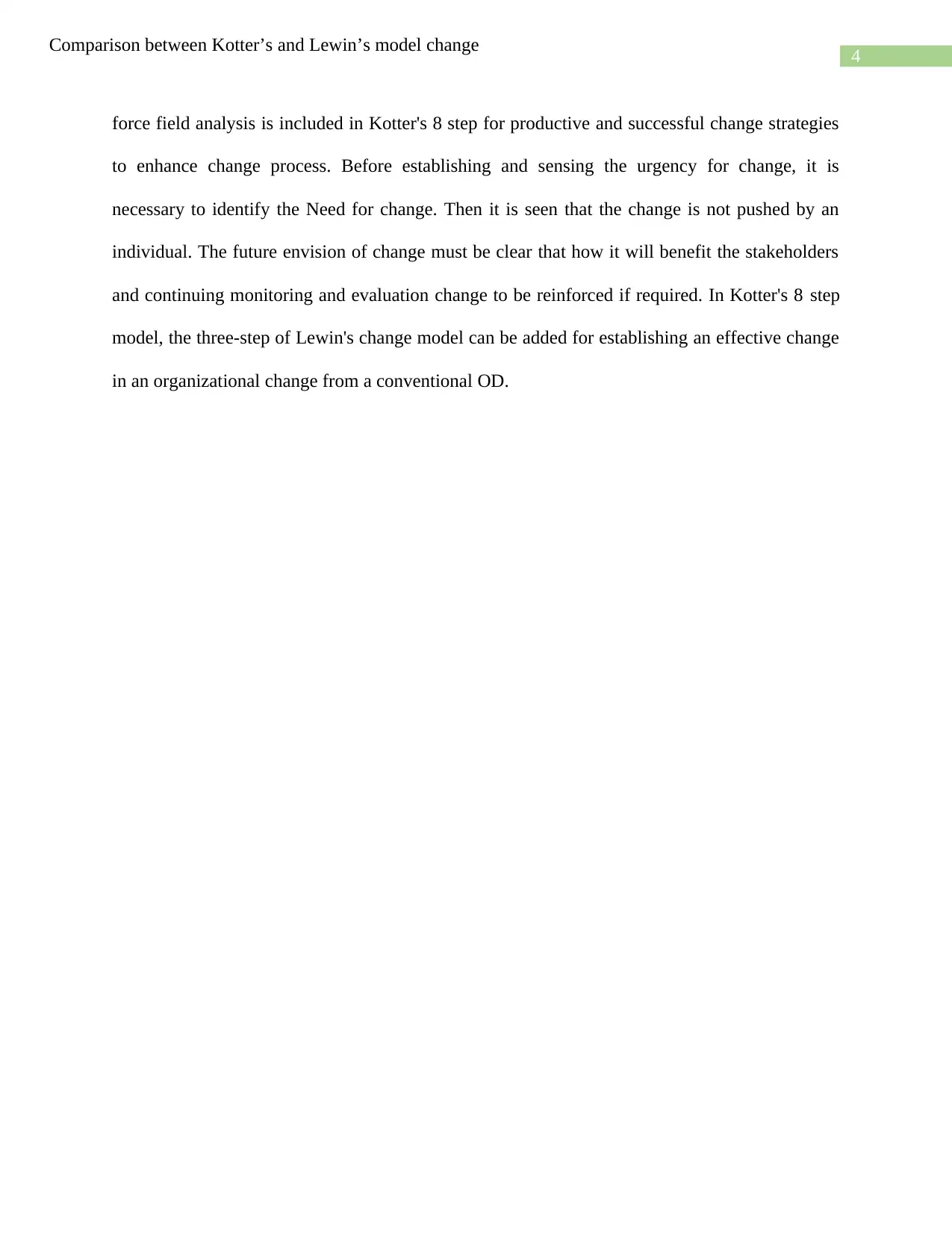
4
Comparison between Kotter’s and Lewin’s model change
force field analysis is included in Kotter's 8 step for productive and successful change strategies
to enhance change process. Before establishing and sensing the urgency for change, it is
necessary to identify the Need for change. Then it is seen that the change is not pushed by an
individual. The future envision of change must be clear that how it will benefit the stakeholders
and continuing monitoring and evaluation change to be reinforced if required. In Kotter's 8 step
model, the three-step of Lewin's change model can be added for establishing an effective change
in an organizational change from a conventional OD.
Comparison between Kotter’s and Lewin’s model change
force field analysis is included in Kotter's 8 step for productive and successful change strategies
to enhance change process. Before establishing and sensing the urgency for change, it is
necessary to identify the Need for change. Then it is seen that the change is not pushed by an
individual. The future envision of change must be clear that how it will benefit the stakeholders
and continuing monitoring and evaluation change to be reinforced if required. In Kotter's 8 step
model, the three-step of Lewin's change model can be added for establishing an effective change
in an organizational change from a conventional OD.
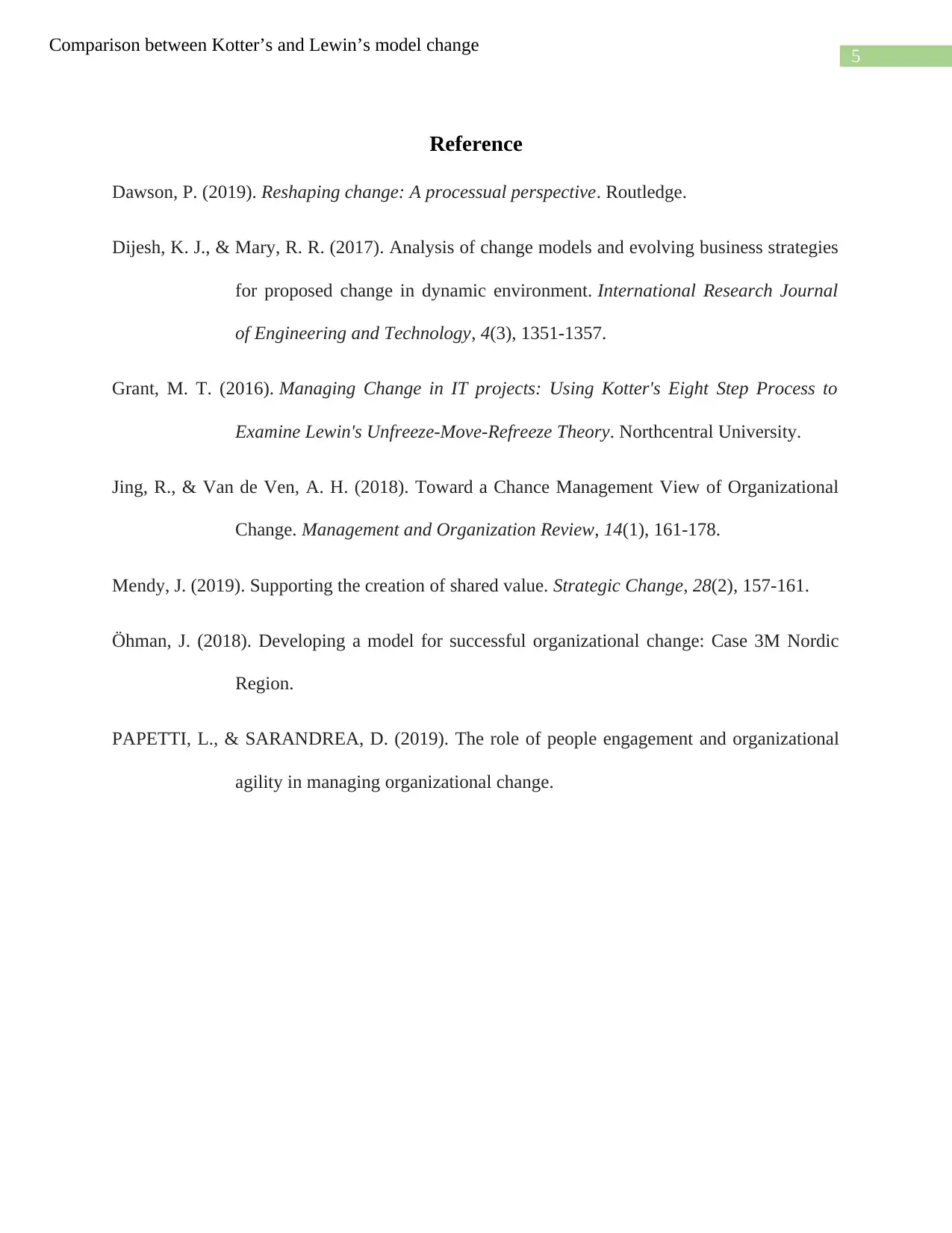
5
Comparison between Kotter’s and Lewin’s model change
Reference
Dawson, P. (2019). Reshaping change: A processual perspective. Routledge.
Dijesh, K. J., & Mary, R. R. (2017). Analysis of change models and evolving business strategies
for proposed change in dynamic environment. International Research Journal
of Engineering and Technology, 4(3), 1351-1357.
Grant, M. T. (2016). Managing Change in IT projects: Using Kotter's Eight Step Process to
Examine Lewin's Unfreeze-Move-Refreeze Theory. Northcentral University.
Jing, R., & Van de Ven, A. H. (2018). Toward a Chance Management View of Organizational
Change. Management and Organization Review, 14(1), 161-178.
Mendy, J. (2019). Supporting the creation of shared value. Strategic Change, 28(2), 157-161.
Öhman, J. (2018). Developing a model for successful organizational change: Case 3M Nordic
Region.
PAPETTI, L., & SARANDREA, D. (2019). The role of people engagement and organizational
agility in managing organizational change.
Comparison between Kotter’s and Lewin’s model change
Reference
Dawson, P. (2019). Reshaping change: A processual perspective. Routledge.
Dijesh, K. J., & Mary, R. R. (2017). Analysis of change models and evolving business strategies
for proposed change in dynamic environment. International Research Journal
of Engineering and Technology, 4(3), 1351-1357.
Grant, M. T. (2016). Managing Change in IT projects: Using Kotter's Eight Step Process to
Examine Lewin's Unfreeze-Move-Refreeze Theory. Northcentral University.
Jing, R., & Van de Ven, A. H. (2018). Toward a Chance Management View of Organizational
Change. Management and Organization Review, 14(1), 161-178.
Mendy, J. (2019). Supporting the creation of shared value. Strategic Change, 28(2), 157-161.
Öhman, J. (2018). Developing a model for successful organizational change: Case 3M Nordic
Region.
PAPETTI, L., & SARANDREA, D. (2019). The role of people engagement and organizational
agility in managing organizational change.
⊘ This is a preview!⊘
Do you want full access?
Subscribe today to unlock all pages.

Trusted by 1+ million students worldwide
1 out of 6
Related Documents
Your All-in-One AI-Powered Toolkit for Academic Success.
+13062052269
info@desklib.com
Available 24*7 on WhatsApp / Email
![[object Object]](/_next/static/media/star-bottom.7253800d.svg)
Unlock your academic potential
Copyright © 2020–2025 A2Z Services. All Rights Reserved. Developed and managed by ZUCOL.



